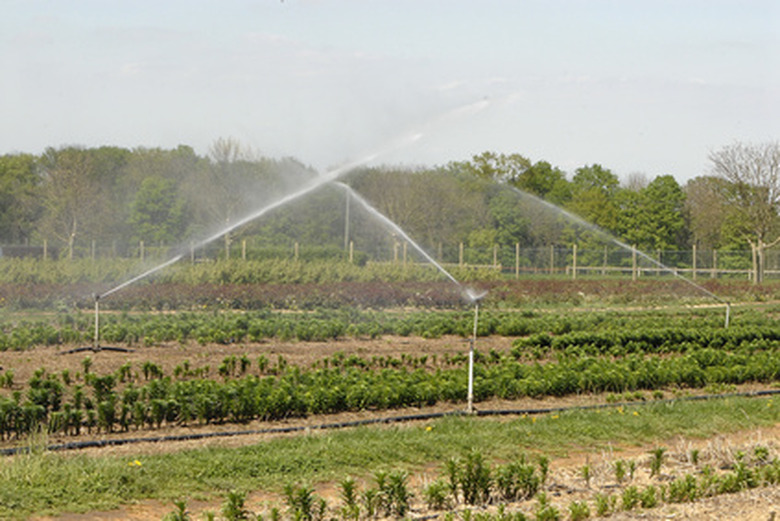Pool Pumps Vs. Irrigation Pumps
Pool pumps and irrigation pumps perform similar functions — the transportation and circulation of water — and in some cases are nearly identical. However, there are enough differences between the two to beg further explanation. To begin with, more types of pumps are commonly used in irrigation systems than are used in either above-ground or in-ground swimming pools. The manner in which the pumps are used also differs slightly between pool to irrigation applications.
Types of Pumps
Types of Pumps
There are two primary categories of pumps used in irrigation and swimming pools: centrifugal pumps and displacement pumps. Displacement pumps use displacement to move water. Displacement dictates that an area of a certain size can only contain so much volume. Thus, when an object such as a piston is introduced into a chamber containing water, water must move to accommodate the volume of the piston. Through this process, water is pumped.
Centrifugal pumps use impellers, or devices that rotate at extremely rapid rates, to circulate water. By rotating water at rapid speeds, impellers create kinetic energy that pushes water outward. The impeller also generates a vacuum, the force of which draws new water into the pump.
Pool Pumps
Pool Pumps
Though there are a number of swimming pool pumps on the market purporting advantages such as horsepower and variable speed capacity, all pool pumps are more or less the same in that they are centrifugal pumps. These pumps are commonly used in swimming pools because they are simple, dependable and, for the most, part self-contained.
Centrifugal pumps used in swimming pools circulate water by creating a vacuum. This vacuum draws water through the pump and pushes it back out after filtering it. The power required of a centrifugal pump is contingent upon the gravity of the fluid being pumped.
Irrigation Pumps
Irrigation Pumps
Both centrifugal and displacement pumps are used in irrigation systems. Displacement pumps are generally considered old-fashioned. A prime example of a displacement pump is a manually operated piston pump. Other types of displacement pumps include diaphragm pumps, roller-tubes and rotary pumps.
End-suction centrifugal pumps are most commonly used in irrigation systems. These pumps are similar to those used in swimming pools, though they differ in that they are primarily used to push water. While swimming pool pumps circulate water through pulling and pushing, end-suction pumps are designed with powerful pushing ability but relatively weak suction capacity.
Other types of centrifugal pumps used in irrigation systems include submersible pumps, turbines and jet pumps, and booster pumps.
Manner of Use
Manner of Use
The most significant difference between swimming pool and irrigation system pumps is the manner in which they are used.
Swimming pool pumps draw water in through centrifugal force, pass the water through a filter, and push the water back into the pool. The filter helps rid the water of bacteria and dirt while the constant motion of the water makes it more difficult for algae and other undesirable aquatic organisms to take root.
Irrigation pumps are used to introduce or drain water from crop areas, gardens, roads and other ground systems. Irrigation pumps do not circulate water; they simply introduce or remove it. Pumps that introduce water to crops are sometimes equipped with filters. Pumps that remove water from overly wet soil or roads do not filter or clean water, they simply drain it.
